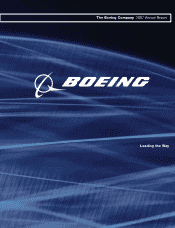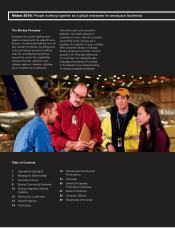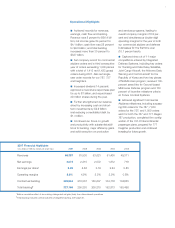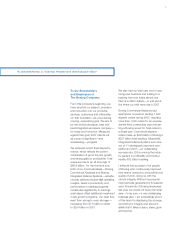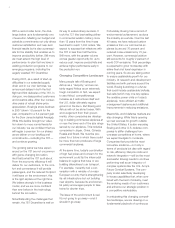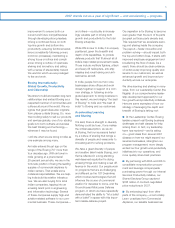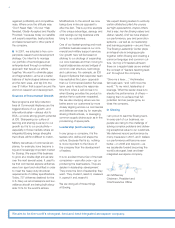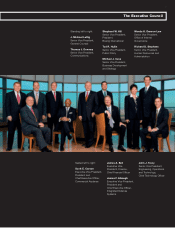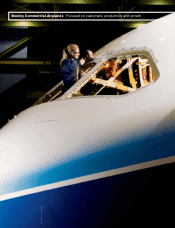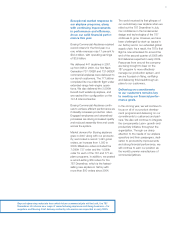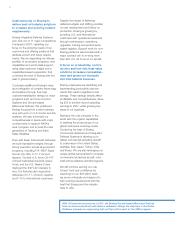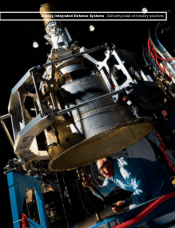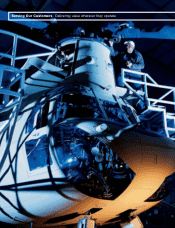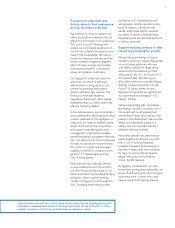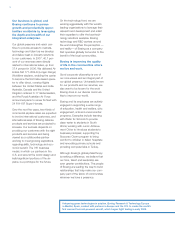Boeing 2007 Annual Report Download - page 7
Download and view the complete annual report
Please find page 7 of the 2007 Boeing annual report below. You can navigate through the pages in the report by either clicking on the pages listed below, or by using the keyword search tool below to find specific information within the annual report.4
With a record order book, the chal-
lenge before us is fundamentally one
of execution. Meeting our budget and
schedule commitments not only drives
customer satisfaction and near-term
financial results but is also a prerequi-
site for the stability that enables us to
improve productivity further. Still more,
we must extend the high level of
performance-to-plan that we have in
existing production programs to our
emerging programs, including the
eagerly awaited 787 Dreamliner.
During 2007, as a result of start-up
difficulties in our extended supply
chain and in our own factories, we
announced delays in both the first
flight and first deliveries of the 787. In
doing so, we disappointed customers
and investors alike. After four consec-
utive years of robust share-price
appreciation, Boeing’s stock declined
in 2007 (down 1.6 percent for the
year, compared to a 6.4-percent gain
for the Dow Jones Industrial Average).
While this decline brought our valua-
tion down to more normal levels for
our industry, we are confident that we
will regain a premium for our shares
as we deliver on our backlog and
commitments— including the 787 —
and continue growing.
The growing pains we have experi-
enced on the 787 are not uncommon
with game-changing innovation.
And that’s what the 787 is all about.
From the economic efficiency it will
deliver for our customers, to the com-
fort and convenience it will provide
passengers, and the reduced footprint
it will leave on the environment, this
is the right airplane at the right time.
We believe strongly in the business
model, and we are more confident
than ever before in the technology
behind the innovation.
Notwithstanding the challenges that
remain, the 787 Dreamliner is well on
its way to extraordinary success. It
took the 737 (the best-selling airliner
in commercial aviation history) more
than 15 years from the time it was
launched to reach 1,000 orders. We
expect to surpass that milestone with
the 787 in less than half the time.
Still more, with the greater volume
comes greater opportunity for us to
reduce cost, improve productivity and
achieve higher performance early in
the production run.
Changing Competitive Landscape
Many people talk of Boeing and
Airbus as a “duopoly,” and we cer-
tainly regard Airbus as an extremely
tough competitor. In fact, we expect
to see Airbus’ competitiveness
increase as it restructures itself and
the U.S. dollar ultimately regains
ground on the Euro. But Boeing and
Airbus will not be alone forever. With
encouragement from their govern-
ments, other companies are develop-
ing or building commercial airplanes at
or near the lower end of the size range
served by our airplanes. This includes
companies in Japan, China, Canada,
Russia and Brazil. We must be pre-
pared for a future in which there could
be more than two producers of large
commercial airplanes.
At the same time, today’s combination
of high fuel prices and concern for the
environment could tip the intermodal
balance in regions that have or are
building alternatives to air transport.
For example, I recently had a con-
versation with a minister of a major
European country that is strengthening
its rail infrastructure but not building
new airports, because its environmen-
tal policy encourages people to take
trains for shorter trips.
The issue of the environment is real.
It’s not going to go away— and it
shouldn’t go away.
Fortunately, Boeing has a record of
environmental achievement, as does
the industry as a whole. Over the last
40 years, we have reduced carbon
emissions from our commercial air-
planes by around 70 percent and
reduced noise emissions by 75 per-
cent. However, commercial aviation
still accounts for roughly 2 percent of
world CO2 emissions. That percentage
is expected to grow moderately with
airline-fleet and travel expansion in
coming years. So we are taking action
to ensure sustainable growth for our
industry. At research-and-development
facilities and with partners around the
world, Boeing is working on a future
that could include sustainable biofuels,
fuel cells (which may one day replace
the auxiliary power units on today’s
airplanes), more efficient air traffic
management systems and additional
improvements in reducing emissions.
Meanwhile, world defense markets are
also changing. While this is opening
up new avenues for growth outside
the United States, it is also exposing
Boeing and other U.S. defense com-
panies to stiffer challenges from
overseas competitors at home, where
we expect budgets to moderate.
Companies that provide the most
innovative solutions— not only in
terms of products but also with regard
to risk, efficiency, lifecycle costs and
network integration— will be the most
successful. Boeing needs to continue
performing well as an integrator of
complex systems like the U.S. Army’s
Future Combat Systems. The com-
pany is also selectively developing
in-house capabilities that, when com-
bined with the best of industry, meet
the enduring needs of our customers
and enhance our strategic position in
a competitive marketplace.
In anticipating this changing competi-
tive landscape, we are drawing on a
fundamental playbook of continuous


